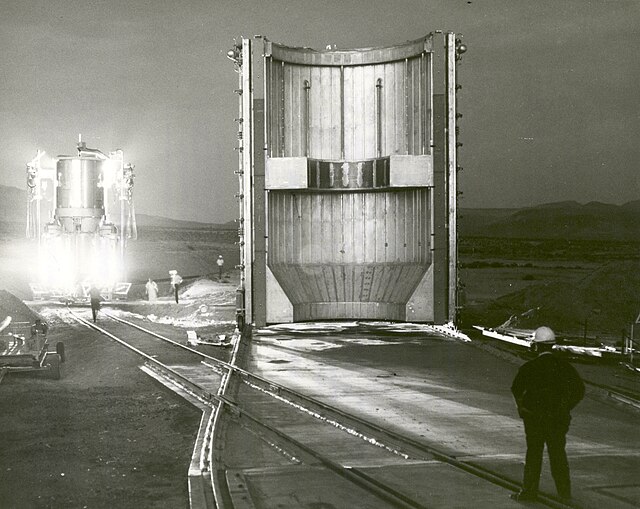Nuclear propulsion includes a wide variety of propulsion methods that use some form of nuclear reaction as their primary power source. The idea of using nuclear material for propulsion dates back to the beginning of the 20th century. In 1903 it was hypothesized that radioactive material, radium, might be a suitable fuel for engines to propel cars, planes, and boats. H. G. Wells picked up this idea in his 1914 fiction work The World Set Free. Many aircraft carriers and submarines currently use uranium fueled nuclear reactors that can provide propulsion for long periods without refueling. There are also applications in the space sector with nuclear thermal and nuclear electric engines which could be more efficient than conventional rocket engines.
USS Nimitz (CVN-68), lead ship of the Nimitz-class of nuclear-powered aircraft carriers
A Delta-class nuclear-powered submarine
A picture of an Aircraft Nuclear Propulsion system, known as HTRE-3 (Heat Transfer Reactor Experiment no. 3). The central EBR-1 based reactor took the place of chemical fuel combustion to heat the air. The reactor rapidly raised the temperature via an air heat exchanger and powered the dual J47 engines in a number of ground tests.
Bimodal nuclear thermal rockets conduct nuclear fission reactions similar to those employed at nuclear power plants including submarines. The energy is used to heat the liquid hydrogen propellant. The vehicle depicted is the "Copernicus" an upper stage assembly being designed for the Space Launch System (2010).
A nuclear thermal rocket (NTR) is a type of thermal rocket where the heat from a nuclear reaction replaces the chemical energy of the propellants in a chemical rocket. In an NTR, a working fluid, usually liquid hydrogen, is heated to a high temperature in a nuclear reactor and then expands through a rocket nozzle to create thrust. The external nuclear heat source theoretically allows a higher effective exhaust velocity and is expected to double or triple payload capacity compared to chemical propellants that store energy internally.
1 December 1967: The first ground experimental nuclear rocket engine (XE) assembly is shown here in "cold flow" configuration, as it makes a late evening arrival at Engine Test Stand No. 1 in Jackass Flats, Nevada. The engine is in the left background with a shield structure in the mid/foreground.
A NERVA solid-core design
Pulsed nuclear thermal rocket unit cell concept for Isp amplification. In this cell, hydrogen-propellant is heated by the continuous intense neutron pulses in the propellant channels. At the same time, the unwanted energy from the fission fragments is removed by a solitary cooling channel with lithium or other liquid metal.
The KIWI A prime nuclear thermal rocket engine








